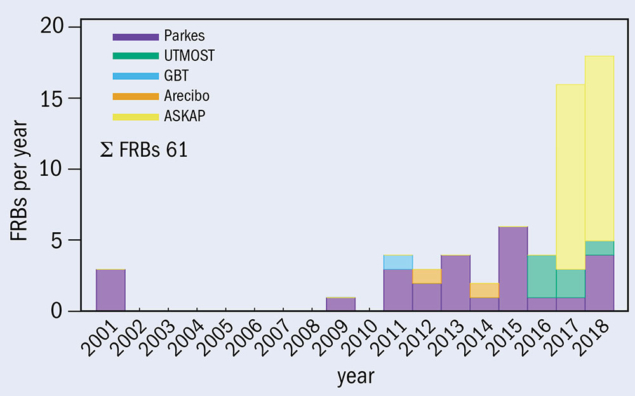
In 2007, while studying archival data from the Parkes radio telescope in Australia, Duncan Lorimer and his student David Narkevic of West Virginia University in the US found a short, bright burst of radio waves. It turned out to be the first observation of a fast radio burst (FRB), and further studies revealed additional events in the Parkes data dating from 2001. The origin of several of these bursts, which were slightly different in nature, was later traced back to the microwave oven in the Parkes Observatory visitors centre. After discarding these events, however, a handful of real FRBs in the 2001 data remained, while more FRBs were being found in data from other radio telescopes.
The cause of FRBs has puzzled astronomers for more than a decade. But dedicated searches under way at the Canadian Hydrogen Intensity Mapping Experiment (CHIME) and the Australian Square Kilometre Array Pathfinder (ASKAP), among other activities, are intensifying the search for their origin. Recently, while still in its pre-commissioning phase, CHIME detected no less than 13 new FRBs – one of them classed as a “repeater” on account of its regular radio output – setting the field up for an exciting period of discovery.
Dispersion
All FRBs have one thing in common: they last for a period of several milliseconds and have a relatively broad spectrum where the radio waves with the highest frequencies arrive first followed by those with lower frequencies. This dispersion feature is characteristic of radio waves travelling through a plasma in which free electrons delay lower frequencies more than the higher ones. Measuring the amount of dispersion thus gives an indication of the number of free electrons the pulse has traversed and therefore the distance it has travelled. In the case of FRBs, the measured delay cannot be explained by signals travelling within the Milky Way alone, strongly indicating an extragalactic origin.
The size of the emission region responsible for FRBs can be deduced from their duration. The most likely sources are compact km-sized objects such as neutron stars or black holes. Apart from their extragalactic origin and their size, not much more is known about the 70 or so FRBs that have been detected so far. Theories about their origin range from the mundane, such as pulsar or black-hole emission, to the spectacular – such as neutron stars travelling through asteroid belts or FRBs being messages from extraterrestrials.
For one particular FRB, however, its location was precisely measured and found to coincide with a faint unknown radio source within a dwarf galaxy. This shows clearly that the FRB was extragalactic. The reason this FRB could be localised is that it was one of several to come from the same source, allowing more detailed studies and long-term observations. For a while, it was the only FRB found to do so, earning it the title “The Repeater”. But the recent detection by CHIME has now doubled the number of such sources. The detection of repeater FRBs could be seen as evidence that FRBs are not the result of a cataclysmic event, since the source must survive in order to repeat. However, another interpretation is that there are actually two classes of FRBs: those that repeat and those that come from cataclysmic events.
Until recently the number of theories on the origin of FRBs outnumbered the number of detected FRBs, showing how difficult it is to constrain theoretical models based on the available data. Looking at the experience of a similar field – that of gamma-ray burst (GRB) research, which aims to explain bright flashes of gamma rays discovered during the 1960s – an increase in the number of detections and searches for counterparts in other wavelengths or in gravitational waves will enable quick progress. As the number of detected GRBs started to go into the thousands, the number of theories (which initially also included those with extraterrestrial origins) decreased rapidly to a handful. The start of data taking by ASKAP and the increasing sensitivity of CHIME means we can look forward to an exponential growth of the number of detected FRBs, and an exponential decrease in the number of theories on their origin.
Further reading
CHIME/FRB Collaboration 2019 Nature doi:10.1038/s41586-018-0867-7.
CHIME/FRB Collaboration 2019 Nature doi:10.1038/s41586-018-0864-x
E F Keane 2018 Nat. Astron. 2 865.
D Lorimer 2018 Nat. Astron. 2 860.








